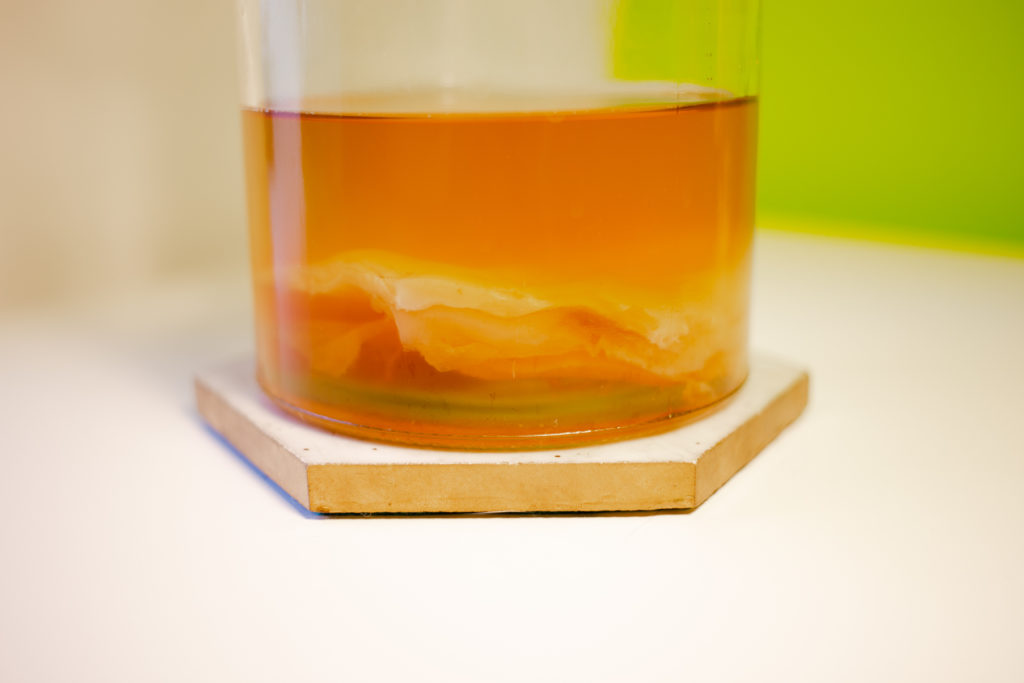I don’t know if it’s where I live or this way everywhere but Kombucha is amazingly hip and popular health drink that is cropping up everywhere. It’s flavorful, zingy, and surprisingly easy to homebrew Kombucha. I’m a full-on first-time homebrewer at anything. At the end of the post, there is a free infographic printable to keep you on track during your first brew!
What is Kombucha? Some hippy wine?
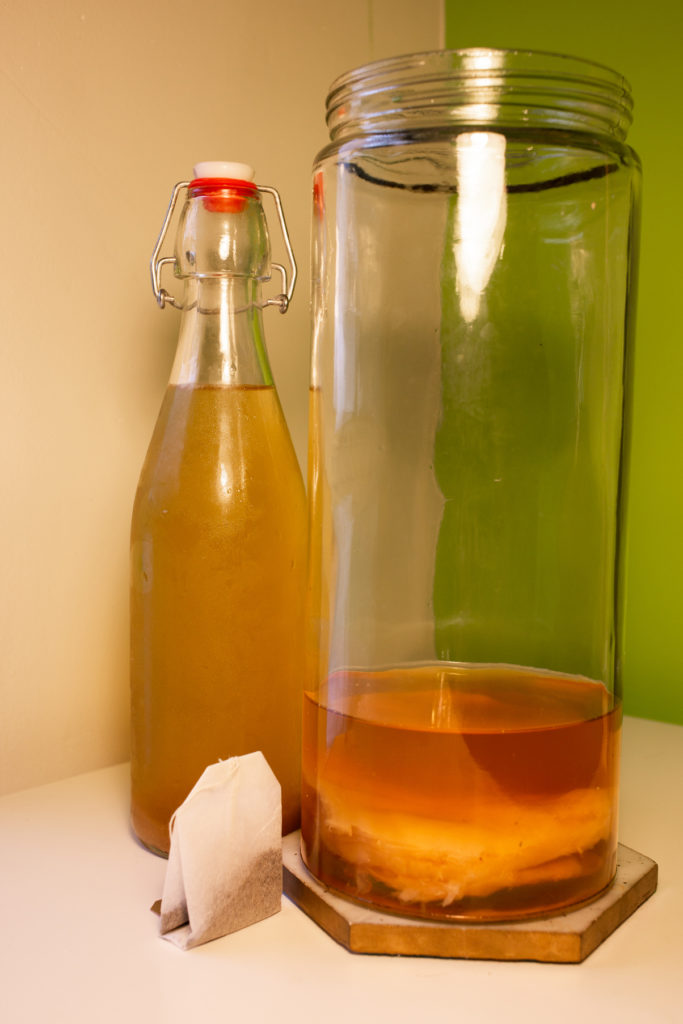
The short answer: No Kombucha is not wine. It’s not beer and definitely not that stuff they make in prisons. I would, however, consider it in the same realm because it is a fermented/cultured drink. It is a fermented sweet tea beverage typically mixed with fruit or juice to customize the flavor.
Much like beer and wine has yeast to process the sugars in the chosen grain and grapes Kombucha has a specific bacterial culture that thrives on the sugar in the sweet tea. This, in turn, gives it a sweet, acidic taste that hits all the same notes as a semi-sweet wine.
There are two phases of brewing Kombucha. The first is the culturing with healthy air circulation. You can drink it after this phase. It is delicious and has all the benefits kombucha fanatics rave about, however, most people do a second fermentation by adding in fruit flavorings and siphoning it into a Grolsch bottle for more carbonation. This post will be a two-part post of my whole Kombucha making process separated by the first fermentation and the second fermentation.
Is Kombucha Alcoholic?
There isn’t really a short answer for this question. Typically Kombucha is sold with other health-orientated drinks like smoothies and juices not wines and beers. However I did just put it in a similar category as beer and wine as a fermented drink.
The fermentation process naturally does have ethanol alcohol as a by-product. If the brewer is actively trying to get the highest alcohol content, Kombucha’s alcohol content maxes out at around 3%. This is even lighter than most light beers.
However, store bought varieties and brews that are not trying to increase alcohol content are around 0.5%. This is lower than what the FDA requires to be classified as an alcoholic beverage. Ergo, it isn’t an alcoholic drink, hence being sold near the smoothies and juices.
Getting drunk off of Kombucha would be an impressive and difficult feat. You’d first throw up from the amount of liquid in your stomach you’d have to consume in a short amount of time. However, if you still have medical health issues with alcohol then yes, there is some.
Health benefits of Kombucha
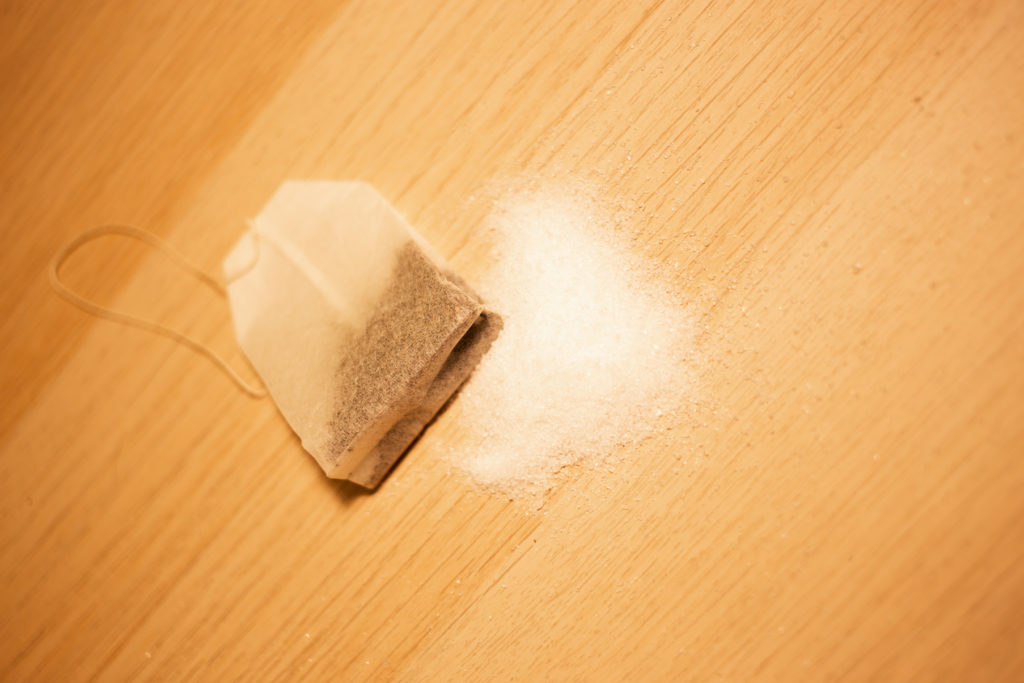
Kombucha has an absurd number of health benefits along with being tasty. Since kombucha is a fermented beverage it is filled with all kinds of good bacteria help the gut microbiome. The fermentation process provides acetic acid (like found in vinegar), B vitamins, and essential minerals. It provides similar benefits to other fermented foods like Kimchi, Sauerkraut, and Natto. The tea itself has the anti-oxidant Polyphenol to assist with inflammation. It has even been shown to be antimicrobial. As always, the buzzword that it can help prevent cancer has been thrown out there.
However, I am also not a doctor. While there is evidence of Kombucha’s ability to do all these things. It will not cure cancer. More than likely the reason why it helps prevent cancer is that those taking the time to drink Kombucha already lead a pretty healthy life which definitely will help prevent cancer. Take all the benefits with a grain of salt and overall enjoy this tasty fizzy beverage.
Getting familiar with the Kombucha Culture: The SCOBY
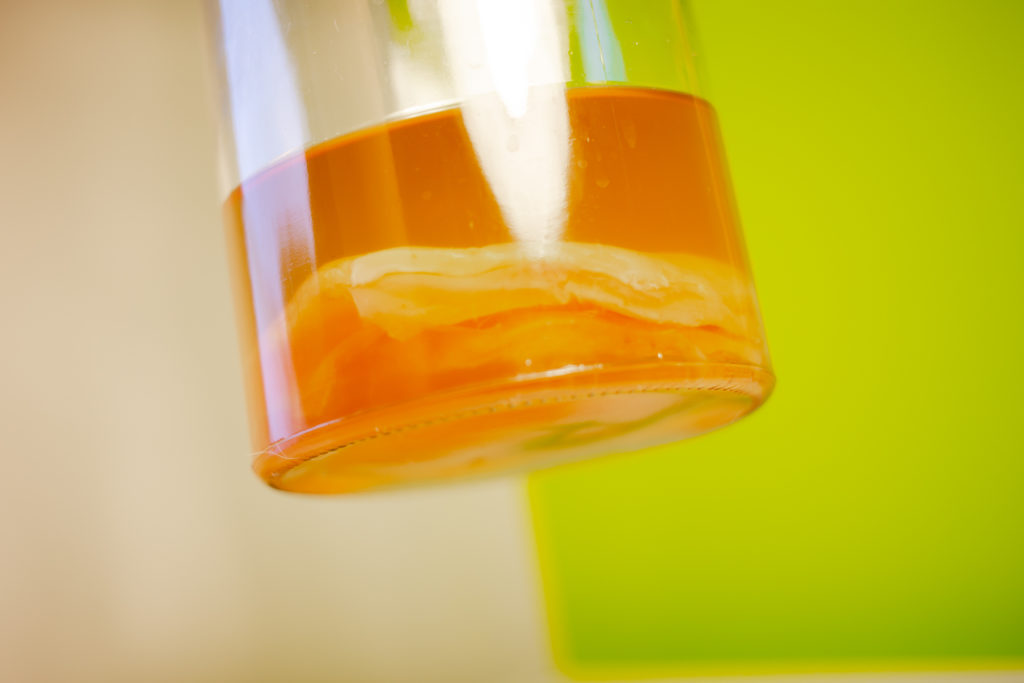
The magic to create Kombucha lies in the bacterial culture. It is the “Symbiotic Culture of Bacteria and Yeasts” or affectionately shortened to SCOBY. Like beer and wine different versions of these cultures will result in different tasting brews.
The SCOBY itself it a bit…weird looking. It made me think of a young stingray. All ghostly and squishy but rubbery looking at the same time. I’ll be honest, I haven’t touched it yet but I’ve been told it feels like it too. It’s not the prettiest thing to look at, but the process to brew beer or make cheese also is not the prettiest thing.
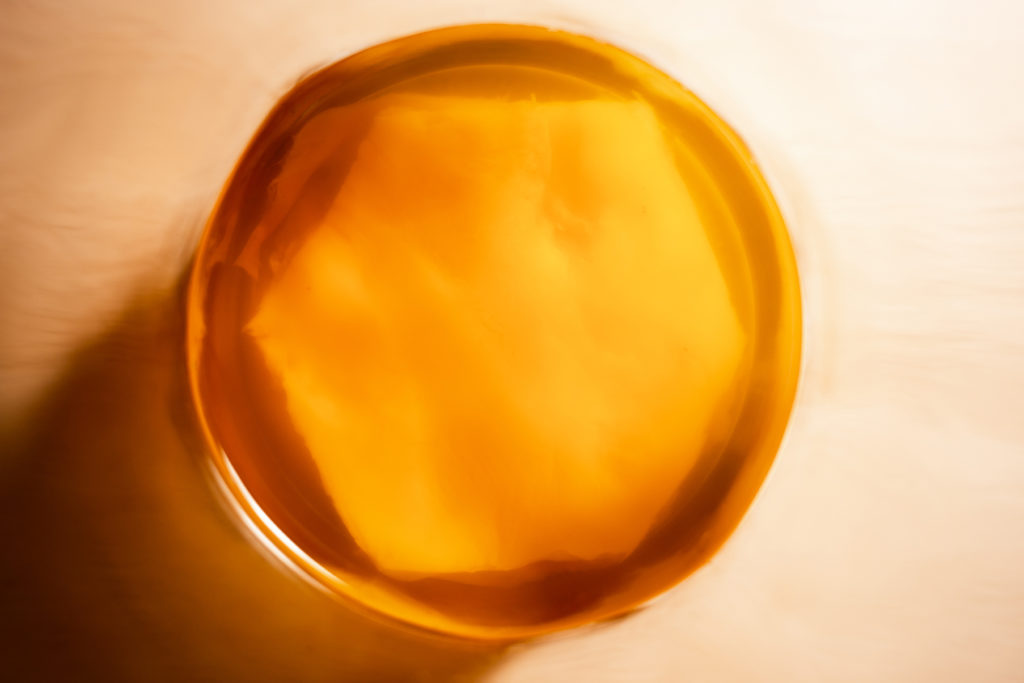
Since the SCOBY is a cluster of single-celled organisms, it grows. So it’s easy to get one from someone who is already homebrewing since they regularly need to cut it down so it doesn’t take up the whole container. I received my SCOBY and starter liquid from my coworker Christian (you can check out some of the other neat things he does in my other post about 3D printing). He ordered his SCOBY online which comes in a vacuum sealed container with some liquid.
Starting the the First Fermentation of Homemade Kombucha
You will need: (20min active work, 4-8hr inactive, 1-3 weeks inactive)
- Black tea
- Sugar
- Filtered water
- SCOBY sample
- Starter liquid from a previous batch
- Large glass OR porcelain fermentation container
- Cotton cloth
- Large rubber band
- Vinegar (for sanitation)
Brewing homemade Kombucha is so easy, it makes me wonder why did I buy for so long. The first thing to do is brew some sweet tea.
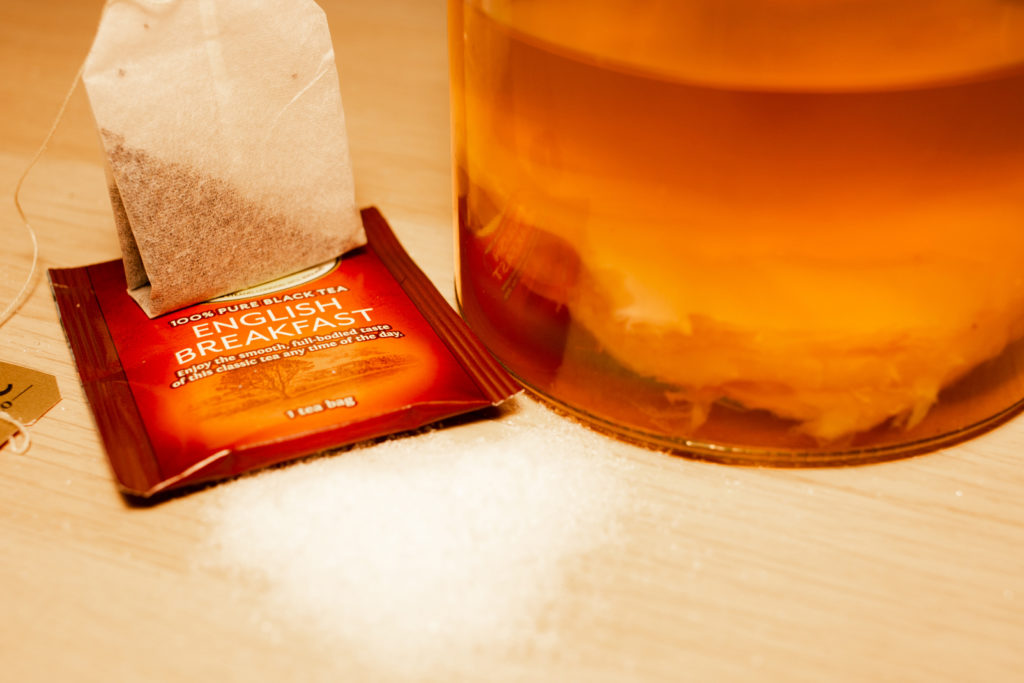
The ratio for 1 gallon of homebrewed Kombucha sweet tea
- 1 gallon near boiling filtered water
- 4-6 bags of black medium quali-tea (hehe)
- 1 cup of sugar
While the water is coming to temperature I sanitize my brewing container with the vinegar and hot water. Absolutely no soap should come into contact with the SCOBY culture. When choosing a container it was commonly stated during my research that metals and certain plastics will also corrupt the brew. With the low PH levels of Kombucha, I can see how the acidity would corrode so I must concede and advise against it.
When the container was sanitized I concocted enough sweet tea for my container. Then I let the sweet tea sit out and cool overnight. You absolutely need to let the sweet tea cool to room temperature otherwise you’ll cook your SCOBY.
Kombucha Container: Continuous Brewing vs. Batch Brewing
There are continuous brews and batch brews. A batch brew is in something like brewing in a gallon mason jar. With each brew, the SCOBY must be fetched out with vinegar-sterilized hands and the whole brew is emptied, sans 1 cup of starter liquid.
I chose a continuous brew which means it’s a container with a metal-free spigot and does not need to be emptied every brew (thus continuous). This was chosen in the name of simplicity and I want to minimize touching the SCOBY. Reasons being for health of the culture (minimal touching is always best) and because the Kombucha SCOBY kinda wigs me out.
Note: Since typing this up I have touched the SCOBY. It does feel like a stingray. Firm and wet like skin stretched over cartilage. While I don’t seem bothered by drinking Kombucha, it seems like my body doesn’t like handling the culture since it gave me a minor allergic reaction. So here’s a warning about that: A massive cluster of yeast and bacteria could cause an allergic reaction.
Finalizing the Kombucha homebrew

Once the sweet tea is room temperature you can add your SCOBY sample and starter liquid. Your Kombucha is starting! How exciting!
To help the fermentation process you need to have it breathe. However, you also need to keep out fruit flies and other pests. You will need a somewhat fine-mesh fabric, cheesecloth has too large of holes. There are these ultra-cute Kombucha brew cap for purchase. However, I just used a piece of cotton fabric left over from making eco-friendly beeswax wraps and a large rubber band. It does the job just as well.
Fermenting the Kombucha homebrew
At this point, it’s all a waiting game. Store the containers at room temperature out of direct sunlight (in a cupboard or pantry is great). You are now waiting for the kombucha to ferment. This will take between 1 to 3 weeks. As it ferments it will develop a subtle sweet-vinegary smell. It is not an overpowering smell, but noticeable within a few feet of proximity.
Much like baking is a form of chemistry where the temperature and humidity can affect the outcome of the baked good, this is biology. Different temperatures and sweetness can change the outcome of the culture to create different brews. The best way to see if it is properly fermented is to taste it starting after one week. Overall though, it’s all about what you prefer.
- Too sweet: Still needs time to ferment
- Too sour/acidic: Oops. Next time ferment less
- Nice tangy-sweet: Perfect level for you. Drink as-is or do a second fermentation.
Kombucha homebrew Printable – Quick Reference
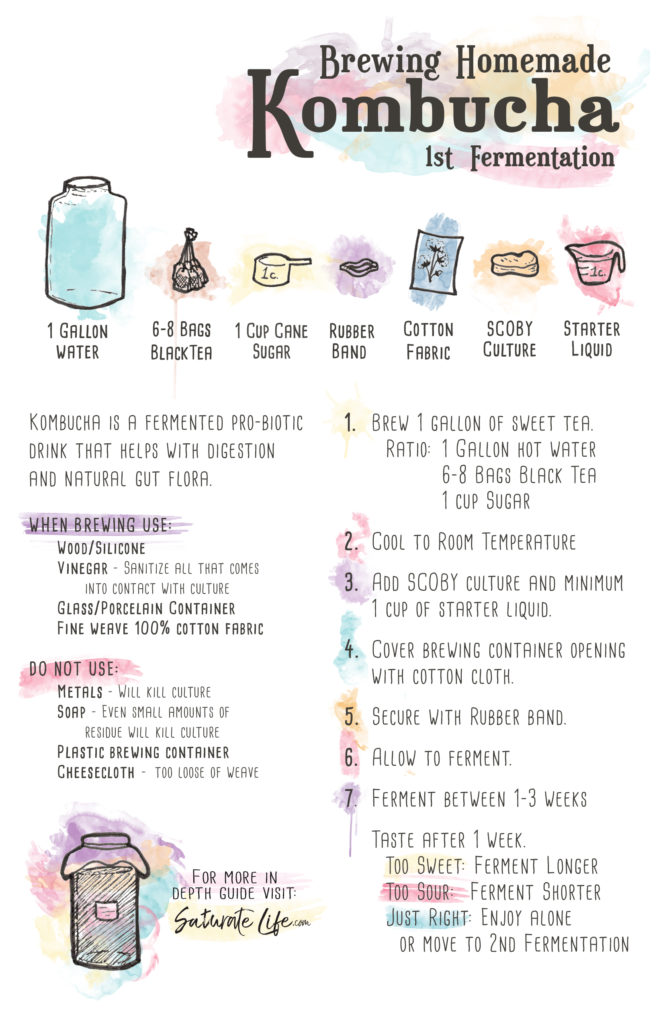
Here’s a quick printable as a reference moving forward with your Kombucha homebrewing. While this isn’t completely comprehensive it is my gift to you as a guide to keep you on track for future Kombucha homebrews. Enjoy!
Thoughts about homebrewing Kombucha
Well, this process is much easier than I ever expected. Since I was gifted the SCOBY (Thanks Christian), the only thing I really needed was the container. I am still in the process of fermenting. But in order to start homebrewing Kombucha, I was pleasantly surprised at how little time and effort it took. It kinda made me wonder why did I even bother buying it to start.
